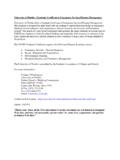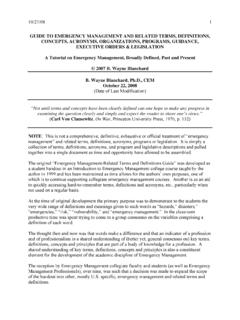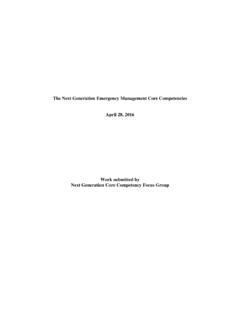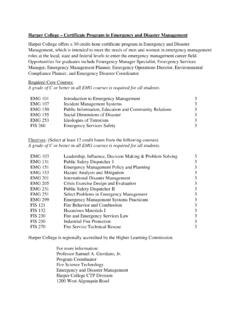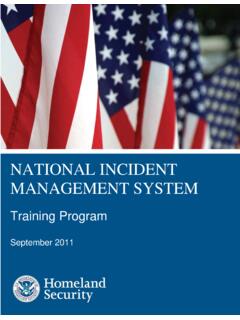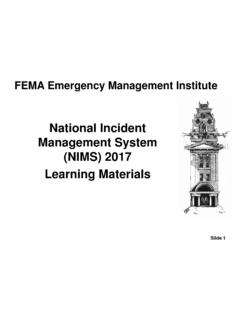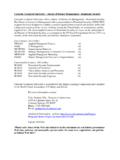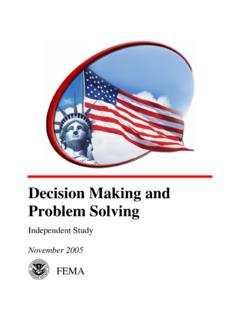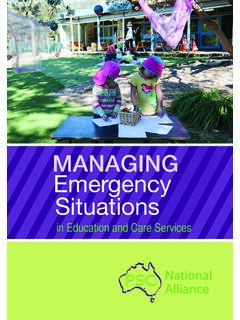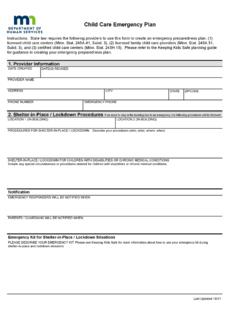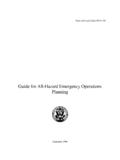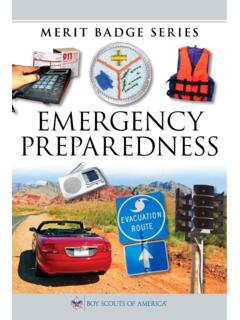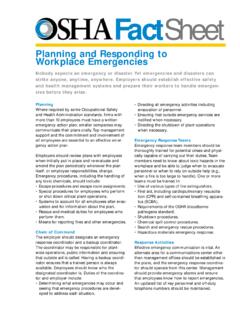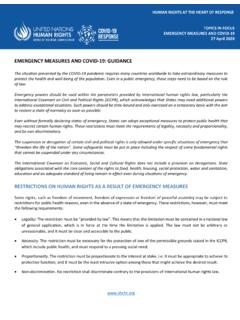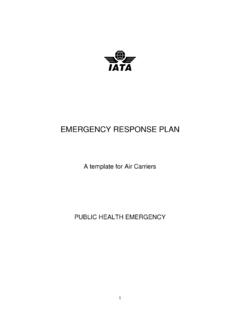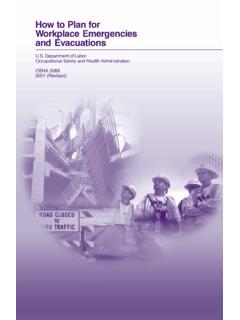Transcription of Military Resources in Emergency Management
1 FEMA IS-75: Military Resources in Emergency Management Table of Contents Table of Contents Course Introduction .. SM CI-1. Course Objectives .. SM CI-4. Course Agenda .. SM CI-5. Course Administrative SM CI-7. Lesson 1: Types of Military Response and Integration of Military SM I-1. Topics Covered .. SM I-2. Objectives .. SM I-3. Defense Support of Civil Authorities (DSCA) .. SM I-4. Levels of Response .. SM I-8. Types of Military Response .. SM I-11. Representatives in a Federal Response .. SM I-28. Activity Worksheet: Representatives in a Federal Response.
2 SM I-29. Mission Assignment Process .. SM I-38. Mission Assignment Process .. SM I-39. Pre-Scripted Mission Assignments .. SM I-40. Activity: The Challenge of the New Madrid Fault .. SM I-45. Lesson Summary .. SM I-56. Lesson 2: Military Resources and Capabilities .. SM II-1. Topics Covered .. SM II-2. Objective .. SM II-4. Military Services .. SM II-5. Military Culture .. SM II-6. Federal Executive Department Control of the Military Services .. SM II-11. Components of the Military Services .. SM II-15.
3 Auxiliaries to the Military Services .. SM II-27. Military Capabilities Useful for Emergencies .. SM II-29. Incident Support Base (ISB) .. SM II-38. Lesson Summary .. SM II-68. Lesson 3: Planning for Military Resources in Military Management .. SM III-1. Topics Covered .. SM III-2. Objectives .. SM III-4. National Incident Management System .. SM III-5. National Response Framework (NRF) .. SM III-7. Integration of Military Resources in Accordance with NIMS and NRF .. SM III-8. Building and Maintaining Key Relationships.
4 SM III-13. Planning for a Maximum Disaster Incident .. SM III-14. Developing a Military Support Emergency Support Function .. SM III-15. Military Support ESF Development Team Members .. SM III-16. Emergency Management Tools .. SM III-19. SM III-21. Lesson Summary .. SM III-22. Course Summary .. SM CS-1. FEMA IS-75: Military Resources in Emergency Management (May 2011). ToC i FEMA IS-75: Military Resources in Emergency Management Table of Contents Appendices .. Appendix A-1. Appendix A: Glossary .. Appendix A-1.
5 Appendix B: Acronyms .. Appendix B-1. Appendix C: ESF Worksheets .. Appendix C-1. FEMA IS-75: Military Resources in Emergency Management (May 2011). ToC ii FEMA IS-75: Military Resources in Emergency Management Lesson 1: Types of Military Response and Integration of Military Support Course Introduction Notes Lesson Information The IS-75 course will take approximately eight hours to complete. The IS-75: Military Resources in Emergency Management course was developed in response to requests from state, local, and tribal Emergency managers who are either researching best practices for integrating Military support Resources into their existing Emergency operations plans and procedures ( , Military Support Emergency Support Function); or, are becoming aware of the Department of Defense's mission to provide support of civil authorities in man- made and/or natural disaster incidents.
6 Multiple jurisdictions across the have recently or are now in the process of developing detailed strategies for integrating available Title 32 ( , National Guard) and/or Title 10 ( , Active Duty and Reserve) Military units/ Resources into their respective disaster response plans, training, and exercise operations. As evidence provides from catastrophic disasters such as the oil spill in the Gulf of Mexico in 2010, Hurricane Katrina in 2005, and Hurricane Andrew in 1992, Military units and activities have proven to be a critical component for successful response and recovery operations.
7 Therefore, it is vital for Emergency managers at every jurisdictional level to possess a rudimentary understanding (at a minimum) of Military Resources ; their capabilities and limitations; and, how to access and integrate them in their respective jurisdiction's disaster response and recovery operations. Without this understanding, there are significant risks of missed opportunities to save lives, mitigate human suffering, and mitigate significant property and/or environmental damage. FEMA IS-75: Military Resources in Emergency Management (May 2011).
8 SM CI-1. FEMA IS-75: Military Resources in Emergency Management Lesson 1: Types of Military Response and Integration of Military Support Notes Lesson Information The purpose of the IS-75: Military Resources in Emergency Management course is to provide students with an overview of Defense Support of Civil Authorities (DSCA); Military Resources potentially available to assist civilian authorities; and procedures for obtaining and integrating Military Resources into disaster response and recovery operations.
9 FEMA IS-75: Military Resources in Emergency Management (May 2011). SM CI-2. FEMA IS-75: Military Resources in Emergency Management Lesson 1: Types of Military Response and Integration of Military Support Class Introductions Notes Lesson Information FEMA IS-75: Military Resources in Emergency Management (May 2011). SM CI-3. FEMA IS-75: Military Resources in Emergency Management Lesson 1: Types of Military Response and Integration of Military Support Course Objectives Notes Lesson Information At the end of this course, you should be able to.
10 Describe the command relationships of local, tribal, state, and Federal incident response assets, including state and Federal Military Resources supporting civilian authorities Describe the types of Military response available to states Describe the representatives, authorities, and assignments involved in a Federal Military forces disaster response Identify the characteristics of the various Military Resources and their associated capabilities useful in an Emergency response Describe the process for developing a Military Support Emergency Support Function (ESF) annex for your jurisdiction Describe the planning products resulting from the planning process FEMA IS-75: Military Resources in Emergency Management (May 2011).
